
An unusually rich “Scytian” burial was found in 1970 near Issik (aka Issyk), near Alma Ata,
Kazakhstan in Central Asia, which also included a silver drinking bowl containing engraved runiform
writing, along with a sword and hundreds of golden decorations that were sewn onto the clothes of
the deceased. This was topped by a very tall conical headdress. The sex of the person buried in
Issik is not certain but may have been a queen, since among her possessions there were also sewing
needles. As we know, the sword and the military symbols were common with Scythian warrior women, who
also took an active part in battles.
http://en.wikipedia.org/wiki/Issyk_kurganThe approximately 2,500 year old drinking bowl with its engraved inscription is the earliest known
example of a
runiform script style ever found in Eurasia, it appears to be similar to the runiform scripts used by Turkic people and Hungarians,
both ethnic Hungarians and Székely (Seklers), and not unique to just one group. According to J. Harmatta,
the inscription has also some similarities with the Kharosthi script.
An ultimate source of these symbols may be the graphemes of ancient Central Europe, the
graphemes of the
Bronze Age cultures of Körös, Tordos and Vincha, the inscription graphemes resemble them, but none
of phonetic values are known. While the graphemes appear to a degree similar in form to each other,
the Turkic, Hungarian, and Etruscan runiform scripts are phonetically different. For example, Forrai’s
(1994) claims that comparisons between Hungarian and Turkic alphabets share about 28.6% similarities
based on form and sound, while the Hungarian alphabet shares about 43.4% with the Etruscan alphabet
of the ancient Tuscany in Italy.
Of course many sounds went through natural changes as the language evolved, which probably
affected these numbers. In Eastern Europe, the Late Scythian writing used a Greek script rather than
runic, albeit their surviving writings are very rare and usually limited to just names written in
Greek. According to the Greek historian Herodotus, different ethnic elements in Scythia had
different languages.
1
The engraving on the drinking bowl of the “golden man” of Issik.
Copied from Sándor Forrai, 1994.
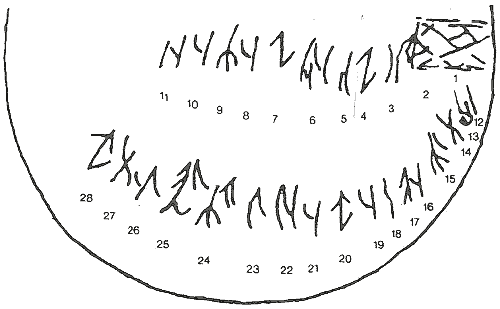
I used a right to left (RTL) analysis of the script as shown in the numbered example, since runic was normally written that way, allowing the right handed person to write in a more convenient way while carving.
LATE FORM OF THE HUNGARIAN RUNIC “ROVÁS”

Suggested normalized transcription using rovás alphabet and rovás compounded scripting technique
Mirrored image from RTL to LTR
.gif)
In Scythian and early Hungarian and Turkic customs, such shallow drinking bowls were tied to the
waist with some clip and belt. Several examples of such cups actually have a buckle on the edge of
the cup. They had both ceremonial and utilitarian usage.
2
Ancient statues in Asia, the Scythian, and the Kipchak grave monuments of 9th-13th cc. in Eastern Europe
and Asia, often depict a person holding a cup as though they were praying for the buried deceased. The “talking” drinking bowl
resembles similar messages found on Etruscan and Roman drinking vessels that addressed the drinker as though the cup was speaking to the person.
Not being an expert on runiform writing, which some Hungarians learn for fun. I specialize on
historical phonetics and sound changes of the Hungarian language in relation to other
languages. My suggestion here is far from being the only possible outcome or a definite evaluation;
however the alphabetic representation found on the drinking bowl, is similar to Hungarian rovás. One
distinction of the Issik runic writing is that due to being scratched onto the rounded surface of
the bowl, it is slightly curved and tilted. Letters aren’t always nice and clear, and neatly aligned
vertically and horizontally, just as our handwriting is not. In my translation, the order of the
letters is from right to left, which was also common in old Hungarian rovás writing. The complex
rounded symbols in Hungarian rovás are difficult to engrave with a knife or chisel, and are rarely
used or were also angular, so it can safely be assumed that they are a later development of the
Hungarian rovás alphabet, not expected in the 5th c. BC. They became useful after more flexible
writing methods were used, rather than the common bichka writing knife. Usually the writing
was engraved on squared wooden rods, and only rarely engraved in metal or stone. They were found
also on rocks or metal, but it was much simpler to carve wood. Light weight and portability must
have been more important then permanence. In Europe, little of the wood carvings remained from
ancient times. Metal objects, especially those from gold were melted down, while stone remnants were
damaged by erosion, covered up, defaced or used for building material.
We cannot expect this 2,500-years old sentence to use modern phonetics, since pronunciation is changing slowly over time and usually the vowels and even some consonants
change slowly and sometimes even fade away. For example, even in the early Middle Ages, the letter O was barely used in Hungarian
documents, while
later, the U usually changed to O or V.
According to historical linguists, the letters D, Ö, LY, F, V, H, B, Z supposedly did not even
exist in ancient Hungarian, so a smaller set of rovás symbols were adequate for these early times.
Vowels were often not included, because they often were not important and phrases could be
understood without them. Many Hungarian phrases can be understood by substituting the same vowel
everywhere in the sentence. To consider the possibility that the Issyk writing is understandable in
Hungarian has its merits, especially since according to the living traditions of the Kazakhstan's
Majars, in Central Asia lived Hungarian splinter tribes from the Eastern Europe. We don’t know when
they moved there, but several early migrations toward Asia from Eastern Europe are known, as
indicated by archeology. Early Sumerian symbols were also found in eastern Europe, in Transylvania
one and a half thousand years before they appeared in Mesopotamia. Some of those symbols are similar
in form and sound to róvás. Letters like D, E, G, Gy, H, I, K, L, M, P, R, T, U, Ü represent root
words in Sumerian, whose main sound reflects Hungarian letters and forms. As in Ha “fish” and the
letter H in Hungarian [Dr Novotny Elemér, Sumir nyelv-magyar nyelv, 1978].
3
There were two known migrations from the Eastern Europe to Asia. One in 2000 BC that ended up in
India and on the Iranian Plateau at about 1600-1500 BC, and another at 1000-700 BC to the Aral Sea
area, by completely different people. In 2000 BC these were Late Neolithic sedentary farming
refugees from the Central Europe, and in 1000- 700 BC they were Timber Grave nomadic Kurganians. The
first is archeologically undetectable. It is known from literary works and also detected
genetically, the second left the relics of Horezmian civilization and is described
anthropologically. Writing, however, is associated with the Zhou Scythians, who brought with them
not only superior nomadic military, but also a developed bronze casting metallurgy, and the art of
writing that grew to be used in the Chinese Bamboo Annals. The Zhou in China came from the west,
where they may have been an offspring of the Su, which is related to Su-bari that eventually was
incorporated into the later Turko-Hunnic groups. In Sumerian, Su was also a distinct dialect of
Sumerian, along with the main Emegir dialect. The unique socketed design of the Zhou cast bronze
axes point to their Mesopotamian origins via the Altai area, and they were exposed to Mesopotamia's
practice of writing. A nomadic group, known as Guties in Mesopotamia, in the 21c. BC, ruled the
Akkadian kingdom for four generations, after which they were kicked out from Akkad. Their language
and Sumerian appears to have many ties to Turkic and Hungarian languages.
In old róvás writing many of the vowels were omitted, because they aren’t needed at all for
morpheme elements, since the vowel is irrelevant and conforms to the root word’s vowel type.
Hungarian rovás script also has a tendency to form joint compounds sometimes termed ligatures,
although they are not depicting different phonemes but a composite that combines letters. The
practice is quite similar to Sumerian cuneiform ligatures which combine two symbols to create not
combined letters but a combined new word, something like the “mail-man”. These compounds are
sometimes the hardest to decipher. For some I used Sándor Forrai’s transcription, who is an expert in
runic writing of various old languages. His book included the Issik inscription without a
translation (Forrai, 1994). Although difficult to read them out of context, they were understood by
many, since even women were reading them as proven by the sewing needles with runiform writing found
in Hungary. Unlike the Romanized versions of the Hungarian alphabet, the róvás alphabet was
perfectly natural for the Hungarian language and reflected Hungarian phonetics, without accents,
modifiers or any combinations. Note that the Hungarian J is unlike English, and is pronounced
as a Y in English (Y in New York).
Transcription and reading
| Image |
Transliteration |
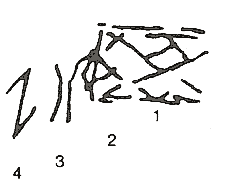 |
 |
| Archaic |
I |
R |
J |
Nu |
A |
SZ |
a |
N |
N - |
aK : |
| Modern |
E- |
Ré- |
J (es) |
Nő |
- A |
SZ - |
o - |
Ñ - |
N - |
aK |
| |
virtuous |
|
woman-queen |
|
|
-for |
|
“For the virtuous-woman, (the)
queen”
The modern asszony means lady but originally meant queen (Györfi György). Asszony
is also a cognate of the Emesal-Sumerian word for queen (g)asan. Transcription separates symbols, and not the words, with spaces.
The first symbol
 is a compound of three separate letters, I, R,
and J. The second symbol
is a compound of three separate letters, I, R,
and J. The second symbol
 is also a compound of 3 symbols N, A, S (or N, S, A). The third symbol
is also a compound of 3 symbols N, A, S (or N, S, A). The third symbol
 has a mirror image of the two N symbols, and it
would look similar to an H if the arches were overlapping, but since they are drawn separately, it cannot be an H but
renders two forms of N. Also, in the Hungarian language the H is a later development, derived from a hard H or KH. The final sign
has a mirror image of the two N symbols, and it
would look similar to an H if the arches were overlapping, but since they are drawn separately, it cannot be an H but
renders two forms of N. Also, in the Hungarian language the H is a later development, derived from a hard H or KH. The final sign
 in the group, which looks like a rotated Z, is a single letter, a word final
grapheme aK.
in the group, which looks like a rotated Z, is a single letter, a word final
grapheme aK.
4
| Image |
Transliteration |
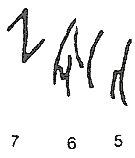 |
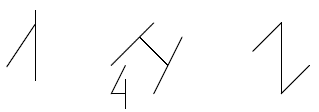 |
| Archaic |
Y-SZ |
SZ- A- T - |
aK : |
| Modern |
ISZ - |
SZ -A- T - |
oK |
| |
drink |
you |
PLURAL |
I.e. “(you) drink”
The first symbol shown
 could be simply a J (English Y) and perhaps combined with an SZ
(English S), but that would make no difference here. The second
compound symbol
could be simply a J (English Y) and perhaps combined with an SZ
(English S), but that would make no difference here. The second
compound symbol  which looks something like a 4 is the slightly clockwise rotated letter A, but to its left
a slightly right-leaning vertical line is the letter SZ, while the symbol that follows it looks something like the form of the Y, which represents a T in rovás. It is commonly a vertical line with a side branch. It is also tilted over a little bit. The final sign
which looks something like a 4 is the slightly clockwise rotated letter A, but to its left
a slightly right-leaning vertical line is the letter SZ, while the symbol that follows it looks something like the form of the Y, which represents a T in rovás. It is commonly a vertical line with a side branch. It is also tilted over a little bit. The final sign
 is a word final aK, which on occasion is also internal to the word, although
internal to the word more commonly used is a diamond shaped eK. That sign is the Sumerian graphemes
for Ki.
is a word final aK, which on occasion is also internal to the word, although
internal to the word more commonly used is a diamond shaped eK. That sign is the Sumerian graphemes
for Ki.
| Image |
Transliteration |
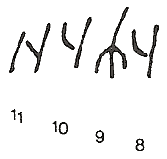 |
 |
| Archaic |
Ti |
ZH, eSZ |
T-é |
Re |
| Modern |
Ti |
SZ |
Té (+let-é) |
Re |
| |
honor |
|
|
-for (her) |
The phrase says “for his/her honor”
The form likeY  is a T in rovás. It is commonly a vertical line with a side branch. The
is a T in rovás. It is commonly a vertical line with a side branch. The
 ZS representing a
palatalized Z, instead instead of SZ “s”, in this example is actually vertically flipped, but there
is no other compatible symbol, unless it’s interpreted as a
compound of SZ+SH, which wouldn’t change the word. The word TiSZTA is close to the Turkic word
töze “clean, pure”. It is claimed to be a form of Slavic chista, probably a cognate of
the same Turkic word. Since the Hungarian sound rules never change ch to t, the Slavic origin
would be unlikely.
Usually, that does not bother etymologists. The
ZS representing a
palatalized Z, instead instead of SZ “s”, in this example is actually vertically flipped, but there
is no other compatible symbol, unless it’s interpreted as a
compound of SZ+SH, which wouldn’t change the word. The word TiSZTA is close to the Turkic word
töze “clean, pure”. It is claimed to be a form of Slavic chista, probably a cognate of
the same Turkic word. Since the Hungarian sound rules never change ch to t, the Slavic origin
would be unlikely.
Usually, that does not bother etymologists. The
 R form for a locative
suffix -r also can be a nearly horizontally slanted line, as is illustrated in the alphabet table
above; both forms were used equally often.
R form for a locative
suffix -r also can be a nearly horizontally slanted line, as is illustrated in the alphabet table
above; both forms were used equally often.
5
| Image |
Transliteration |
 |
 |
| Archaic |
SZá |
TO |
B a |
| Modern |
SZá- |
D - |
B a |
| |
mouth |
your |
into |
This means “into your mouth”
The second lower part of the symbol
 is a
compound of the O, which was extended to include T on it’s top. Since the ancient Hungarian
purportedly didn’t have voiced stops like Etruscan or early Sumerian, the B and D couldn’t have been used,
and various forms of aspirated Th or Dh and Ph, Bh would have evolved into D and B. The second lower
part of the symbol is a ligature of the O, which was extended to include T on it’s top.
is a
compound of the O, which was extended to include T on it’s top. Since the ancient Hungarian
purportedly didn’t have voiced stops like Etruscan or early Sumerian, the B and D couldn’t have been used,
and various forms of aspirated Th or Dh and Ph, Bh would have evolved into D and B. The second lower
part of the symbol is a ligature of the O, which was extended to include T on it’s top.
| Image |
Transliteration |
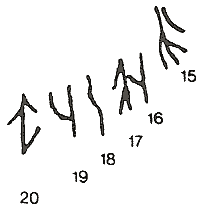 |
 |
| Archaic |
J ZS |
aTa |
P>Vi |
SZ >Zé |
T :: |
C/S- aK : |
| Modern |
IS>ÖS - |
aTya : |
Bi>Vi - |
Zé - |
T : |
CSAK |
| |
ancient |
father |
water |
his |
|
only |
This means “(we drink) only the waters of god (ancient-father)” .
The character  is a compound of the above J and ZS;
is a compound of the above J and ZS;
 stands for Pi/Vi/Bi
addressed above;
stands for Pi/Vi/Bi
addressed above;  is a compound of C/S- and AK : addressed above.
is a compound of C/S- and AK : addressed above.
The  Ata or Ada means father in a range of languages, from Turkic to Sumerian, Dravidian, and others,
Cf. Sumerian ada, Hungarian atya, Turkic ata, Dravidian attan, Celtic atair;
the origin of the Celtic atair ascends to some Central Asian, Eastern European, or
Mesopotamian areas that were
homes for the other examples of shared words. That is consistent with with the attestations of the Celtic migration
from the Eastern Europe to Iberia and predomination of the R1b Y-DNA among the Celtic people.
Ata or Ada means father in a range of languages, from Turkic to Sumerian, Dravidian, and others,
Cf. Sumerian ada, Hungarian atya, Turkic ata, Dravidian attan, Celtic atair;
the origin of the Celtic atair ascends to some Central Asian, Eastern European, or
Mesopotamian areas that were
homes for the other examples of shared words. That is consistent with with the attestations of the Celtic migration
from the Eastern Europe to Iberia and predomination of the R1b Y-DNA among the Celtic people.
The word  IS is an archaic form of ÖS, signifying ancient or ancestor.
It is quite similar to the Turkic "ačV". The usual Hungarian word for God also includes this
element as YS-TEN which became ISTEN, a word for an invisible to the eye “ancestral
god/spirit”, Tengri in Turkic and Dingir in Sumerian.
IS is an archaic form of ÖS, signifying ancient or ancestor.
It is quite similar to the Turkic "ačV". The usual Hungarian word for God also includes this
element as YS-TEN which became ISTEN, a word for an invisible to the eye “ancestral
god/spirit”, Tengri in Turkic and Dingir in Sumerian.
| Image |
Transliteration |
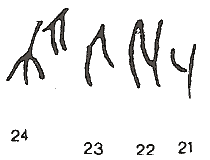 |
 |
| Archaic |
Tá- |
R - |
SHa- |
S- SZá- G |
| Modern |
Tá |
R - |
SHa- |
S- Sá- G |
The meaning is: “the social group, society, or the tribe”
The ancient Hurrian-Urartuan-Mittani languages of northern Mesopotamia and Anatolia also used
this same word as tarshua, referring to all the people of a group, a collective appellation.
Etruscan may also have taken their self designation from there. The  T looks similar to a Y, in it’s most commonly used form, followed by the most common form
T looks similar to a Y, in it’s most commonly used form, followed by the most common form
 of the R mentioned
earlier. The following symbol
of the R mentioned
earlier. The following symbol  S/SH could easily be confused with an “I” except that it usually has a shorter line crossing vertical staff. Instead, it is the letter SH (S in Hungarian) slightly tilted counterclockwise. Then the last
compound
S/SH could easily be confused with an “I” except that it usually has a shorter line crossing vertical staff. Instead, it is the letter SH (S in Hungarian) slightly tilted counterclockwise. Then the last
compound
 is again either ZS (pronounced like
J in French name Jock ), or SZ+SH; it is followed by a leaning character shaped as a
Roman F that represents G.
is again either ZS (pronounced like
J in French name Jock ), or SZ+SH; it is followed by a leaning character shaped as a
Roman F that represents G.
6
| Image |
Transliteration |
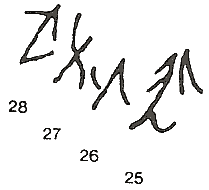 |
 |
| Archaic |
eGé–S-éG |
Jó? |
I |
CAK: |
| Modern |
eGé S-éG |
Jó (+re) |
I - |
SZ-uK: |
| |
health & wholeness |
good (for) |
drink |
- we |
It should be noted that transcription separates symbols, and not the words, with spaces. In this
case ISZUK 
 means “we drink it” so that CAK/SZUK in the above example does not mean “we”. The first symbol
means “we drink it” so that CAK/SZUK in the above example does not mean “we”. The first symbol
 is a
compound of G that looks like a leaning reversed F, then an SH below it, and another G facing to the right. This means
“health”. The second is the letter J, (English Y) which is JÓ and means “good ”, as in “good health”. A similar word is used in
Turkic and Finno-Ugric languages to mean “good”. The next letter
is a
compound of G that looks like a leaning reversed F, then an SH below it, and another G facing to the right. This means
“health”. The second is the letter J, (English Y) which is JÓ and means “good ”, as in “good health”. A similar word is used in
Turkic and Finno-Ugric languages to mean “good”. The next letter
 is an I, followed by a
compound of TS “C”+AK addressed above, it is a compound of the upward pointing arrow and the word final AK
that resembles a rotated Z. The C pronounced as “Ts” in this word in modern Hungarian is softened to SZ (s). This phrase may represent an archaic grammatical feature, where the adjective follows the noun, similar to Sumerian and some
Finno-Ugrian languages, where it can sometimes be used either leading or lagging the
noun. Indications are that unlike a definite word order, in everyday speech Sumerian had both word orders,
that is attested by the remnants of the scribal tablets of the Sumerian students, in their scribal schools
the students at times had the order reversed.
is an I, followed by a
compound of TS “C”+AK addressed above, it is a compound of the upward pointing arrow and the word final AK
that resembles a rotated Z. The C pronounced as “Ts” in this word in modern Hungarian is softened to SZ (s). This phrase may represent an archaic grammatical feature, where the adjective follows the noun, similar to Sumerian and some
Finno-Ugrian languages, where it can sometimes be used either leading or lagging the
noun. Indications are that unlike a definite word order, in everyday speech Sumerian had both word orders,
that is attested by the remnants of the scribal tablets of the Sumerian students, in their scribal schools
the students at times had the order reversed.
Combining all the phrases together, we obtain the following sentence:
“Drink [isz] yea(pl) [uk] to the honor [tiszt] of [-nak] the virtuous [eréj(es)]
-woman [nő]- (the) queen [asszoñ], (the) water [viz] of god [ős-atya].
Only [Csak] for [ra]
(the)
health/wholeness [egész-ség] (of the) society/community [társa-ság] we [uk] drink [isz]”
In Hungarian:
“Eréj(es) nő asszonynak iszátok tiszte(let)ére (az) ös-atya vizét. Csak a társaság jó egészségére iszuk”
The word order of the Hungarian to English translation is in proper English grammar, not in Hungarian
grammar. The word order in the actual text matches the correct word order in Hungarian grammar.
Various archaic agglutinative languages initially did not use
an article (the) and later had to borrow it from neighboring languages. In agglutinative languages, affixes serve as discriminators between verbs and nouns, so no articles are needed, and they need not to be borrowed, unless the language is creolized and lost its functional affixes, like has the English.
Thus, the Turkic, Finnish, and Sumerian had to borrow articles from other languages; Hungarian adopted the word for
“that” and used it also for
“the”. Therefore, the absence of articles in the inscription is natural.
Incredibly, after 2,500 years, the reconstructed Hungarian translation is almost too “modern” and too
grammatically perfect. That outcome is quite unexpected. A few suffixes are missing; probably they were not needed then.
The adjectival marker -Vs, for example, is used only when it helps to clarify the word. However, the
reconstructed phonetics is somewhat less close, particularly due to expected softening of sibilants like
C “ts” to SZ, and ZS to Sh.
7
According to J. Harmatta (1999), the language of the inscription came from a “Khotan Saka” dialect of
the Scythian language. The script is a sufficiently close version of the Kharosthi script to be
readable, and the dating of the Issyk kurgan and its artifacts is in error because in the 5th c. BC,
the Kharosthi script did not exist yet, thus Harmatta suggests to amend the date to the third
century BC. At the same time, Harmatta notes “similarity of several letters to the characters of the
Orkhon–Yenisey Türk runic script”, and the “more archaic, more angular, simpler letter forms than
the other” inscriptions written in Kharosthi. The Orkhon-Enisean alphabets are younger than the
Issyk inscription by a millennia. To fill that gap Harmatta offers as sources for those distinctly
non-Kharosthi graphemes “the Aramaic prototypes of both the Kharosthı and the Sogdian letters (the
latter serving as models for the Türk runic signs)”. The “Aramaic prototypes” ascend as far back as
9th c. BC, but to undermine the credibility of the Harmatta's suggestion, they have no connection with the
distinctly non-Aramaic origin of the unique letters of the Orkhon-Enisean alphabets used in the
Issyk inscription. The Hungarian róvás script is also forced into an Arameic origin. At the same time, the connection of the Issyk and Orkhon-Enisean alphabet
with the Phoenician alphabet is attested by the presence of the letter s/sh found in these
alphabets, and also in the Aramaic and Hebrew daughters of the Phoenician script; that connection
lies outside of the Harmatta's purview of the “several letters (similar) to the characters of the
Orkhon–Yenisey Türk runic script”.
In his reading of the inscription in Kharosthi, the Harmatta reading of those “several letters (similar) to the characters of the Orkhon–Yenisey
Türk runic script” absent in Kharosthi is not explained.
The unfortunate absence of transcription in the Harmatta's essay does not allow neither a
reconstruction of that reading nor its analysis. The circular logics in the dating, where the dating
is asserted on the premise of the dating of the Kharosthi script, which is the premise underlying
the reading, likewise undermines the credibility of the Harmatta's suggestion for the dating. The Harmatta's
use of the misnomer Khotanese Saka, i.e. the Hotan language assumed to be the unknown
language of Sakas, also undermines the credulity of the Harmatta's reading. The Harmatta's version
reads:
“The vessel should hold wine of grapes, added cooked food, so much, to the mortal, then added
cooked fresh butter on”
The Harmatta's reading translated to English numbers 19 words plus 2 articles, and 89 letters
excluding 2 articles. A tough case to make from a base of total 25 to 28 letters of the inscription.
To comprehend the meaning of the Harmatta's reading is even more perplexing, either as cooking instructions
for a fruit cocktail (wine of grapes), a dinner (cooked food), or an
appeal to a deceased (to the mortal), and the assumption that some sane scribe would scratch
this profanity as a last gift to a prince or queen.
Another reading along the Indo-European lines is that of S.V. Riabchikov (date). Riabchikov's reading involves a Slavono-Indo-Arian-Minoan
Linear A (B) alphabets and identical complement of languages. The credulity of the Riabchikov's
reading is beyond incredible. The Riabchikov's version reads:
“fairytale horse; in, into, at fury; aspiration
Fire, the path though the sky; to turn round and round; this is fire/top; sky”
Afterword
There are at least 10 versions as to the meaning of the inscription, while next to nothing is
actually known about the various Scythian languages. Herodotus
reported 7 Scythian languages in the Eastern European Scythia alone. Nothing is positively known of
those 7 languages. The sheer number of words in Harmatta's and S.V. Riabchikov translations, like a similar
state for the Turkic attempts, appear to greatly overload the number of symbols used, with resultant rather pointless phrases.
The proposed translation at least is meaningful and barely deviates from the grammar and phonetics of the Hungarian language.
Also, it is incumbent to note that more than a single language used similar script, as the similar Turkic, Etruscan and Hungarian scripts prove.
The Etruscan however is alleged to derive its alphabet from the early Greek and Phoenician.
In general, historians avoid the Hungarian róvas alphabet, it was mislabeled as a 14th century creation, because there are many examples found from that period, when the reformation churches started using it again. The
later alphabet just “coincidently” happened to include graphemes similar to much older graphemes from thousands of years earlier.
In the 10th century Pope banned the older Hungarian rovás, referred to by earlier chronicles. As strange and illogical
as is to ban something that did not exist yet, it was very typical of the kind of linguistic
science in Hungary that still lingers today. Hungarian historiography is full of outsider linguists, such as Paul Hunsdorfer, one of the founders of the Hungarian Finno-Ugric theory,
who have gone to great lengths to obliterate róvas. Collection of “rovás” of Gábor Szentkatolnai,
and who knows how many others, were physically destroyed. In the end, that is but one of the many reasons
why Hungarians resent the theses of the reigning linguistics as a science, and those linguists who show contempt for
the Hungarian cultural traditions.
8
 The
oldest inscription in Türkic alphabet, the Issyk
Inscription, written on a flat silver drinking cup, was found in 1970 in a royal tomb located
within Balykchy (Issyk), a town in
Kyrgyzstan near Lake Issyk, and was dated by 5th c.
BC. In the tomb was a body of a man dressed from head to toe in magnificent attire, the clothes,
jacket, pants, socks, and boots all had a total of 4,800 attached pieces of pure gold, greatest ever
found in a tomb except Pharaoh Tutankhamen. The top of the cone-shaped crown covering ears and neck
carried golden arrows emblem. A sword on the belt right side and a knife on the left were in
sheaths. Beautiful relief ornaments of animal art decorated shields, belt and front of the hat.
Radiocarbon tests determined the age of the finds as belonging to the fifth century BC. What was the
world in the 5-th century BC? We have archeological discoveries, where dating is almost always
somewhat speculative, and reconstructions of the ancient Greek maps, and the views of the
Mesopotamian and Chinese records. From the Mesopotamian, Chinese, and Greek texts, from the
archeological discoveries of the kurgans, from the written monuments, we get a glimpse of the
nomadic nations of the Central Asia in the 5-th c. BC. The various interpretations of the graphics
and contents of the inscription witness the paucity of the finds and the potential for the studies.
The
oldest inscription in Türkic alphabet, the Issyk
Inscription, written on a flat silver drinking cup, was found in 1970 in a royal tomb located
within Balykchy (Issyk), a town in
Kyrgyzstan near Lake Issyk, and was dated by 5th c.
BC. In the tomb was a body of a man dressed from head to toe in magnificent attire, the clothes,
jacket, pants, socks, and boots all had a total of 4,800 attached pieces of pure gold, greatest ever
found in a tomb except Pharaoh Tutankhamen. The top of the cone-shaped crown covering ears and neck
carried golden arrows emblem. A sword on the belt right side and a knife on the left were in
sheaths. Beautiful relief ornaments of animal art decorated shields, belt and front of the hat.
Radiocarbon tests determined the age of the finds as belonging to the fifth century BC. What was the
world in the 5-th century BC? We have archeological discoveries, where dating is almost always
somewhat speculative, and reconstructions of the ancient Greek maps, and the views of the
Mesopotamian and Chinese records. From the Mesopotamian, Chinese, and Greek texts, from the
archeological discoveries of the kurgans, from the written monuments, we get a glimpse of the
nomadic nations of the Central Asia in the 5-th c. BC. The various interpretations of the graphics
and contents of the inscription witness the paucity of the finds and the potential for the studies.
 An unusually rich “Scytian” burial was found in 1970 near Issik (aka Issyk), near Alma Ata,
Kazakhstan in Central Asia, which also included a silver drinking bowl containing engraved runiform
writing, along with a sword and hundreds of golden decorations that were sewn onto the clothes of
the deceased. This was topped by a very tall conical headdress. The sex of the person buried in
Issik is not certain but may have been a queen, since among her possessions there were also sewing
needles. As we know, the sword and the military symbols were common with Scythian warrior women, who
also took an active part in battles.
An unusually rich “Scytian” burial was found in 1970 near Issik (aka Issyk), near Alma Ata,
Kazakhstan in Central Asia, which also included a silver drinking bowl containing engraved runiform
writing, along with a sword and hundreds of golden decorations that were sewn onto the clothes of
the deceased. This was topped by a very tall conical headdress. The sex of the person buried in
Issik is not certain but may have been a queen, since among her possessions there were also sewing
needles. As we know, the sword and the military symbols were common with Scythian warrior women, who
also took an active part in battles.


.gif)













